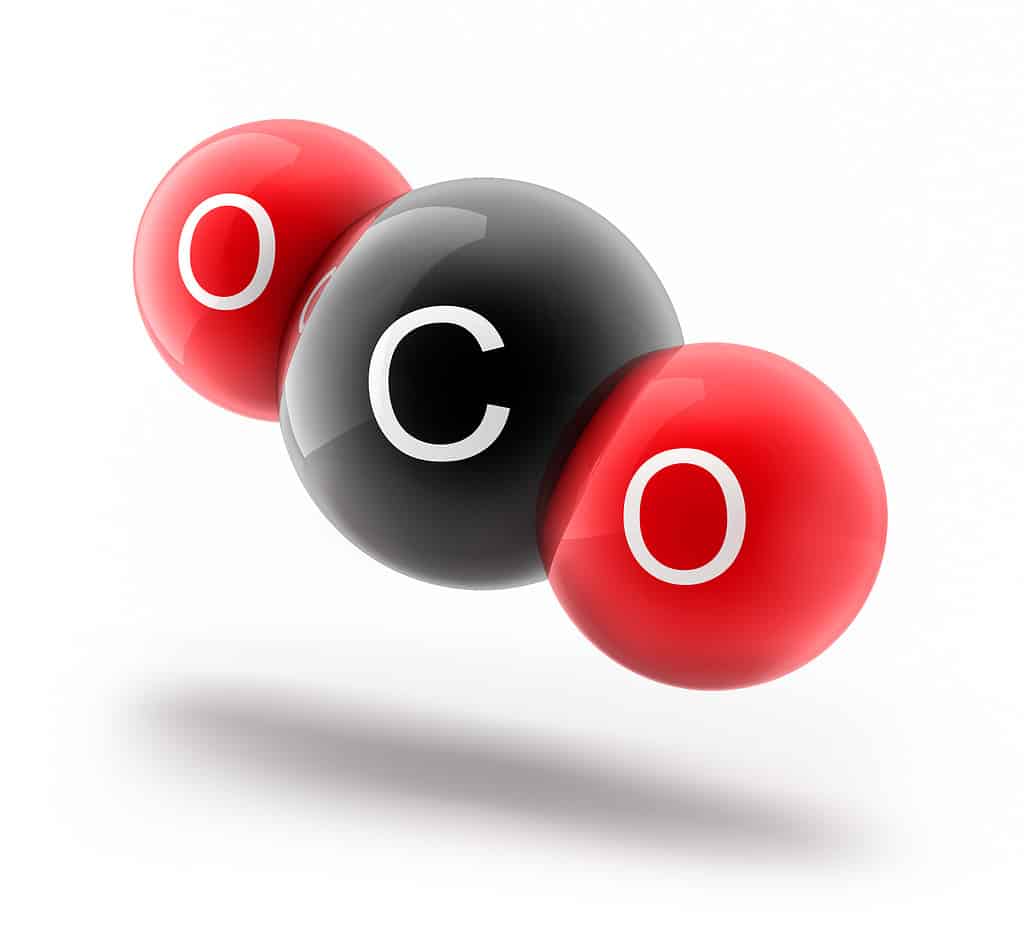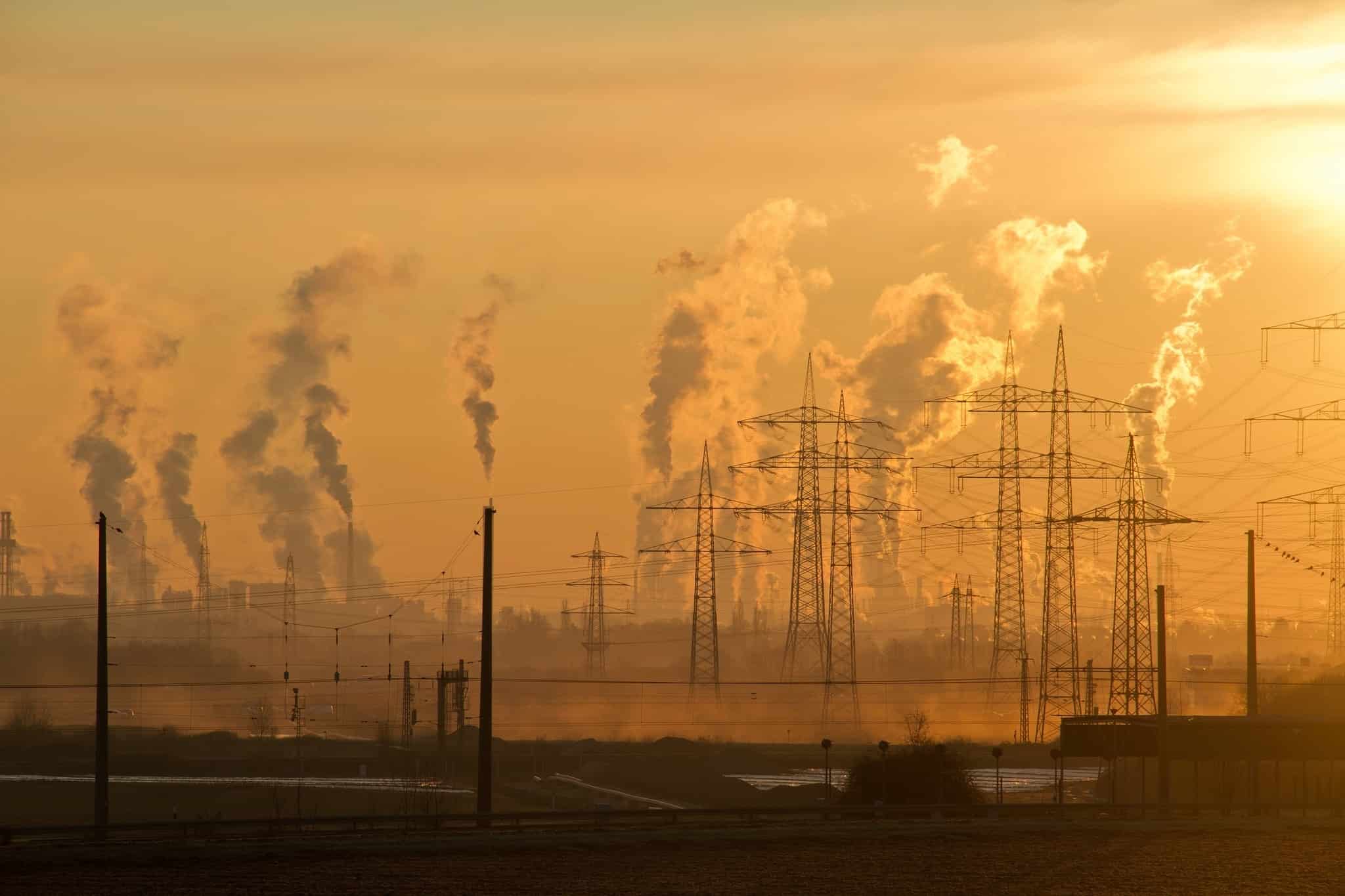Carbon dioxide is a colorless, odorless gas found throughout our atmosphere and stored in the ocean, in rocks, and in many other substances. You might have heard a lot about this compound in recent years. Rising levels of carbon dioxide are believed to be a major contributor to climate change. The concentration of this greenhouse gas in the atmosphere is increasing year by year, driven in part by the consumption of fossil fuels. Yet carbon dioxide is such a necessary compound that life on our planet could not exist without it. Plants use carbon dioxide and produce the oxygen that so many other organisms depend upon. We rely on carbon dioxide, yet we need to find a way to keep it in balance. In this article, we will discover the molar mass of carbon dioxide and how this gas compares to other compounds.

Plants alone cannot keep up with the production of carbon dioxide in our industrial age.
©Galeanu Mihai/ via Getty Images
The Molar Mass of Carbon Dioxide
Every pure substance, meaning every element or chemical compound, has a defined molar mass. The molar mass of a substance influences its physical and chemical properties. A substance’s molar mass is simply the mass, in grams, of one mole of that substance.
A compound is a substance made up of two or more atoms in a defined ratio. Carbon dioxide, with the molecular formula CO2, is made of one atom of carbon and two atoms of oxygen. The atomic mass of carbon dioxide is 44.01 atomic mass units, and its molar mass is 44.01 grams per mole.
In chemistry, a mole is a set number of particles, whether atoms or molecules. That number is a constant, meaning it is the same exact number in every circumstance. The number of particles in a mole of any substance is approximately 6.022 × 1023 units, also known as Avogadro’s number or Avogadro’s constant. This constant, named for the Italian scientist, Amadeo Avogadro, is essential to understanding chemistry and how the world works.
Calculating the Molar Mass of Carbon Dioxide
In carbon dioxide, which is a compound, the smallest particle of the substance is the CO2 molecule. That means there are 6.022 × 1023 molecules of CO2 in each mole of carbon dioxide. But within each molecule of CO2, there are two oxygen atoms and one carbon atom. Therefore, in one mole of carbon dioxide, there are two moles of oxygen atoms and one mole of carbon atoms.
The molar mass of each element on the periodic table is simply its atomic mass expressed in grams. The atomic mass of an element is determined by adding the number of protons plus the average number of electrons in all the known isotopes, weighted by their proportion as found in nature. This number can be found on the periodic table, usually just below the element’s symbol.
Carbon, element number six on the periodic table, has a measured atomic mass of 12.011 atomic mass units. Its molar mass, then, equals 12.011 grams per mole. Oxygen, element number eight on the periodic table, has an atomic mass of 15.999 atomic mass units and a molar mass of 15.999 grams per mole. Therefore, the molar mass of carbon dioxide would equal the molar mass of one mole of carbon plus two moles of oxygen.
| Calculating Molar Mass of Carbon Dioxide |
|---|
| Chemical equation for carbon dioxide: C + 2O –> CO2 |
| 1 mole of carbon + 2 moles of oxygen –> one mole of carbon dioxide |
| 12.011 grams C/mole + 2(15.999 grams O/mole) = 44.01 grams CO2/mole |
Carbon Dioxide in the Atmosphere
Carbon dioxide is not a particularly abundant gas in the atmosphere. It represents only about 0.04 percent of the atmosphere, compared to oxygen, which makes up 21 percent, and nitrogen, which accounts for 78 percent. However, carbon dioxide is an extremely important component because of its ability to trap and reflect heat. Scientists estimate that the atmosphere contained about 280 parts per million carbon dioxide before the industrial revolution. Based on data taken from ice cores, the level of carbon dioxide had been steady at about that same level for close to 12,000 years. This changed with the mass burning of fossil fuels that began less than 200 years ago.
According to the National Oceanic and Atmospheric Administration, NOAA, the concentration of carbon dioxide in the atmosphere rose to roughly 315 parts per million by 1960. As of May 2023, the amount of carbon dioxide in the atmosphere reached 423 parts per million and it continues to rise. That is an increase of more than 50 percent over the steady levels of the pre-industrial period.
Where does Carbon Dioxide Come From?
Most of us learned at a young age that carbon dioxide comes from humans and many other living organisms. We breathe in oxygen and our body converts it to energy and the waste product, carbon dioxide. Plants, in turn, take in carbon dioxide and put out oxygen. It’s a beautiful cycle that allows life on this planet to thrive.
What many of us do not learn is that carbon dioxide comes from many other sources, too. The consumption of fossil fuels, for transportation and producing electricity among other things, releases stored carbon dioxide into the air. Chemical reactions that take place during the manufacture of goods, including all sorts of plastics, also cause the release of the compound. Volcanic or geothermal activity can release the gas, and the agricultural industry increases carbon dioxide emissions as well.
Physical States of Carbon Dioxide
Carbon dioxide exists only as a gas at standard temperature and pressure. It has a measured density roughly 1.5 times that of dry air, but it mixes well in the atmosphere. The compound never forms a liquid at standard pressure. It only liquefies at pressures over 5.11 atmospheres..
If cooled to very low temperatures, carbon dioxide will freeze, or form a solid. This happens at approximately -78.5 °C, or about -109.3°F, at standard pressure. Carbon dioxide in its solid state is known as dry ice. If the temperature is raised beyond the freezing point, the compound will return directly to a gas in a process known as sublimation.
Dry ice has many uses, including freeze-drying or flash-freezing foods and medical samples, keeping things cold where standard refrigeration is not an option, removing warts, fitting metal pipes, creating spooky theatrical effects, and so much more. One reason dry ice is so effective is that it does not turn into a liquid at standard atmospheric pressure. That means there is no wet mess when frozen carbon dioxide transitions back into its gaseous state. Of course, when the gas from the sublimation of dry ice is released back into the air, it adds, ever so slightly, to the percent composition of carbon dioxide in the atmosphere, so it should be used judiciously.

Dry ice undergoes sublimation, turning directly from solid to gas, at standard pressure.
©chorboon_photo/ via Getty Images
Atomic Structure of Carbon Dioxide
Carbon dioxide has a linear structure with the carbon atom in the middle and the oxygen atoms to each side. Carbon has four electrons in its outer shell, but it wants to have eight electrons in the outer shell to achieve the stable configuration of the nearest noble gas, neon. Oxygen has six electrons in its outer shell, and it likewise wants to reach a stable configuration with eight electrons in the outer shell. Carbon can bond to two oxygen atoms by sharing two of its electrons with each oxygen. Each oxygen, in turn, shares two of its electrons with the carbon atom.
Through this sharing, or covalent bonding, the carbon atom in carbon dioxide forms a strong double bond with each oxygen atom. The electrons move unbelievably fast around the bonded atoms, spending time in the outer orbitals of each atom in a sort of super-fast time share arrangement. The carbon ends up with its own four electrons, plus two from each oxygen, while each oxygen ends up with its original six electrons plus two that it pulls from the carbon. Every atom in the compound enjoys a stable eight-electron configuration at least part of the time.

One carbon atom bonds to two oxygen atoms in a linear structure to form carbon dioxide.
©peterschreiber.media/ via Getty Images
The linear shape of carbon dioxide results from the oxygen atoms orienting themselves around the carbon atom in such a way as to give each other the maximum amount of space. The molecule does not maintain a rigid, linear shape, though. It actually vibrates continuously and changes shape, very slightly, over and over again, just like other linear molecules that contain more than two atoms.
Other Familiar Compounds
Carbon Monoxide
Carbon monoxide, a potentially deadly gas, is made of one carbon atom and one oxygen atom. With a molecular formula, CO, carbon monoxide has a molar mass of 28.01 grams per mole. Carbon monoxide forms through the incomplete burning of carbon-based substances. These can include natural gas, propane, coal, charcoal, gasoline, oil, kerosene, or even wood. Carbon monoxide is colorless and odorless, but it is toxic to humans and other animals. It binds to hemoglobin, preventing the transport of oxygen molecules in our blood. Excess exposure can lead to brain damage, heart damage, and even death. Mild exposure may cause headaches, dizziness, and nausea. A carbon monoxide detector can help to detect dangerous levels of the gas and prevent illness and death.
Carbonic Acid
Carbonic acid forms when carbon dioxide dissolves in water. It has the chemical formula, H2CO3, with two hydrogen atoms, one carbon atom, and three oxygen atoms in each molecule. You may be most familiar with carbonic acid as the compound that gives carbonated beverages their fizz. These liquids must be kept under pressure in order to prevent the carbonic acid from breaking down into carbon dioxide and water through a series of reactions. When a bottle of soda is opened and bubbles immediately start to form, these are the result of carbon dioxide gas being released from the carbonic acid in the solution. If a carbonated beverage is left open to the air, it will eventually go flat by converting most of the carbonic acid in the solution back to carbon dioxide and releasing it into the atmosphere.
Other Compounds with a Similar Molar Mass
Several other compounds have a molar mass similar to that of carbon dioxide. This compound’s molar mass, as you will recall, is 44.01 grams per mole. Here are a few other compounds with a comparatively close molar mass.
| Compound Name | Chemical Formula | Molar Mass | Phase at STP |
|---|---|---|---|
| Carbon dioxide | CO2 | 44.01 g/mol | Gas |
| Propane | C3H8 | 44.10 g/mol | Gas |
| Nitrogen dioxide | NO2 | 46.01 g/mol | Gas |
| Ozone | O3 | 48.00 g/mol | Gas |
| Acetaldehyde | CH₃CHO | 44.05 g/mol | Liquid/Gas |
| Sodium fluoride | NaF | 41.99 g/mol | Solid |
Conclusion
Carbon dioxide is an essential compound in our world. It is both necessary for our survival and potentially deadly if not kept within controlled limits. We must strive to understand this important compound, its structure, and how it behaves in nature. Limiting the production of excess carbon dioxide in our modern age has proven difficult. Figuring out ways to sequester the compound may be the key to removing excess molecules of the gas from the atmosphere, but we are a long way from reaching that solution on a workable scale. You may not think that you can make a difference, but every effort helps.
Thank you for reading! Have some feedback for us? Contact the AZ Animals editorial team.








